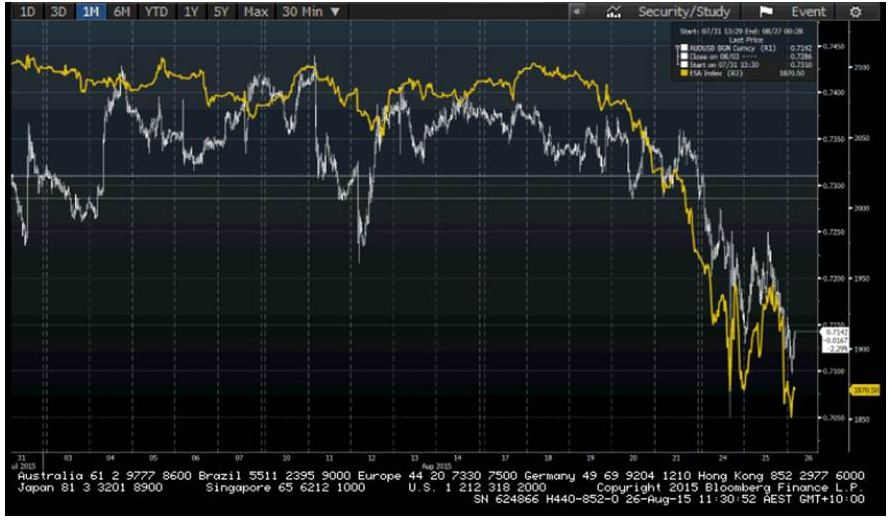A certain calm has descended on Asian markets today, allowing traders to catch a much-needed breath.
It still feels as though volatility can break out at any time and a quick 1-2% move in US futures, Nikkei 225, S&P/ASX 200 or Hang Seng could materialise at any time. Of course, these sort of moves will happen when the US volatility index (VIX) is at 36% (over double the year average) and the S&P/ASX 200 VIX is at 28% (year average 16%). Things can get dicey quickly.
The moves in global markets have been huge; this will happen when market players can’t get an accurate sense of the near- or long-term outcomes. Many market participants cannot even pin-point one specific reason for the elevated volatility. In saying that, the People’s Bank of China (PBoC) is blaming the strong selling being seen on potential tightening from the Federal Reserve, while most Asian emerging market nations are blaming the volatility on the Chinese actions. If traders haven’t got a firm grip on the key catalysts, then this is clearly echoed by the policy makers as well!
Many are blaming algorithmic trading for the sharp moves. While there is no doubt there are some rule-based systems at work, in my opinion, this is a poor excuse. Traders should look at the root of the concerns rather than the mechanism by which they are moving, and we will see high frequency trading take hold in these uncertain times. The uncertainty is ultimately leading to increased correlations in markets. You can see this clearly in the Bloomberg chart below if you just overlap a short-term chart of the AUD/USD and the S&P 500 futures (by way of example).

At the time of writing, stronger buying is being seen in the Chinese equity markets, but price action is fairly whippy. The market has seen through yesterday’s 25 basis point cut in benchmark lending rate and the 50 basis point cut to the reserve ratio requirement (RRR). One questions why they didn’t ease over the weekend. The extra liquidity injected into the banking system would be somewhere between RMB650 billion and RMB700 billion, which sits nicely with the recent use of shorter-term liquidity tools. Most understand this easing for what it is: a policy move aimed at counteracting the tightening of financial conditions caused by sizeable capital outflows. This is not going to boost growth.
There is a view that the concern stemming from China is not one of a natural feedback loop between the Chinese equity markets and the economy. It is more of a view that the markets simply haven’t responded to the raft of measures imposed on market participants from both the regulator and central bank. This is critical, especially in China where traders have traditionally moved into an asset class as a result of guidance from authorities. Another interesting view, and one which I think has merit, is looking to buy Chinese equities if we get a clearer sense of a massive physical stimulus or unsterlised asset purchases (quantitative easing). Put in another way – wait for the government to really get the big guns out. That is clearly not in the markets sights at this stage, and the next likely step would be for stamp duty cuts when trading stocks.
Locally in Australia, the market is moving higher in-line with the Chinese market. One of my personal favourite contrarian buy indicators flashed red yesterday on open, with a mere 12% of ASX 200 companies trading above their 50-day moving average – this has been an accurate contrarian indicator over the last five years. Some 27% of companies printed a 52-week low yesterday and while this doesn’t sound too extreme, it was still the highest percentage since 2011.
The focus now falls firmly back on the US, and specifically on New York Fed president Bill Dudley, who will field questions from the press on the local and regional economies. Mr Dudley’s views will be scrutinised by the market, and given the recent change in language last week from Dennis Lockhart (the Atlanta President), it’s hard to get a sense of whether he is going to give an indication of a September hike.
Mr Dudley and his colleague Stanley Fischer (speaking this weekend at the Jackson Hole Symposium) could be the catalyst for better days for the bulls as it give us a chance to see the world through the eyes of the Fed. It should provide much needed clarity for a market that is desperately searching for answers. Given the subject of Mr Dudley’s speech is about the global economy, it is therefore very fitting for the macro concern, and I would not want to be positioned too far on the short side if he gives us a sense that the concerns are overdone.
Given the S&P 500 is down 9.1% since the July Federal Open Market Committee (FOMC) minutes were released, there is no doubt part of the volatility in global markets has stemmed from Fed concerns. Mr Dudley may give us a chance to rationalise what we have seen. Could this speech give us the answer we so desperately need?
